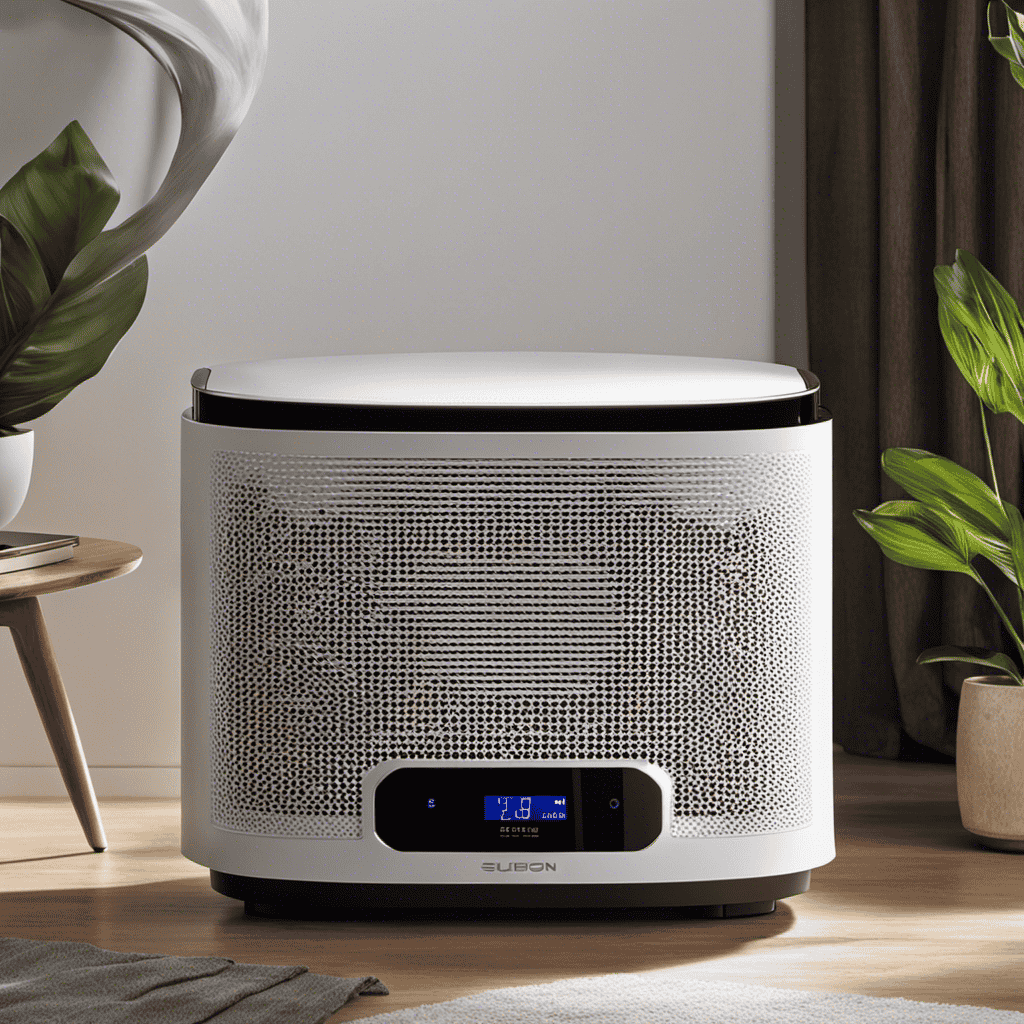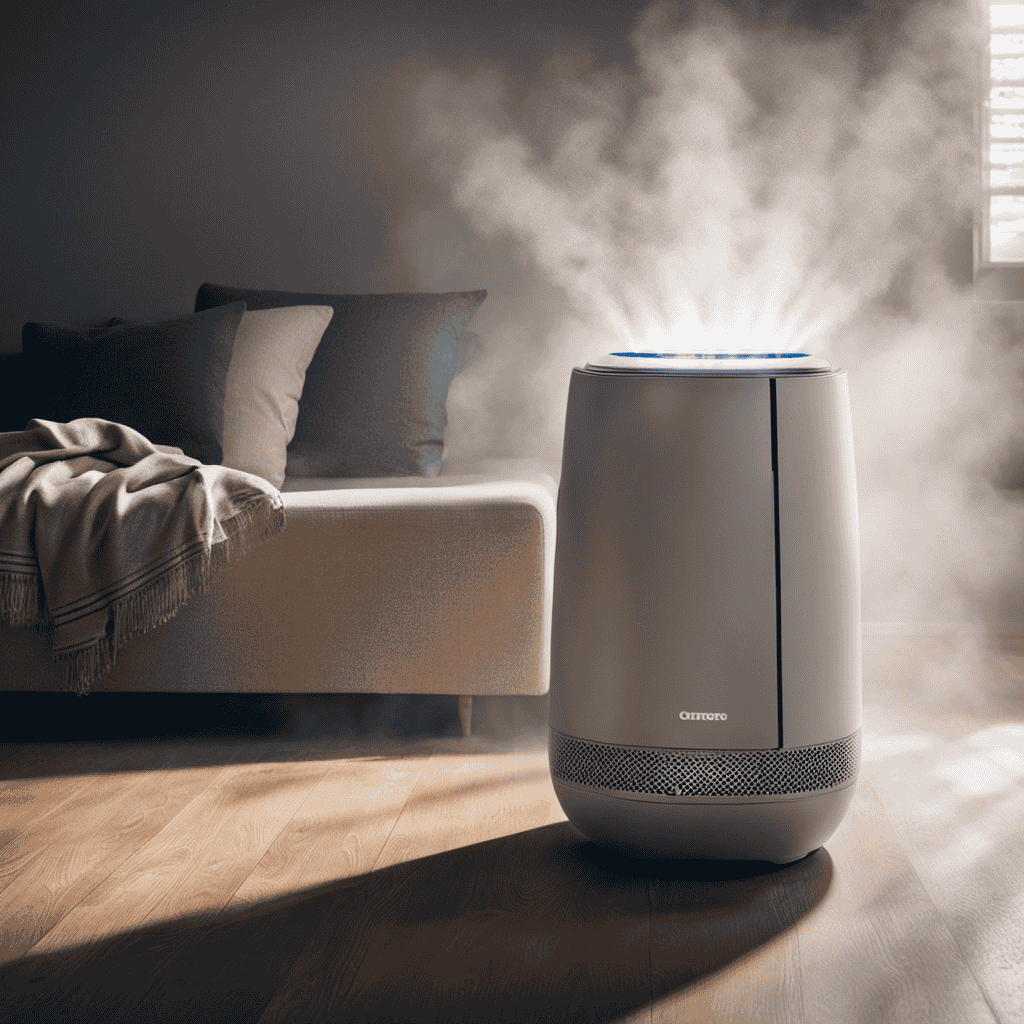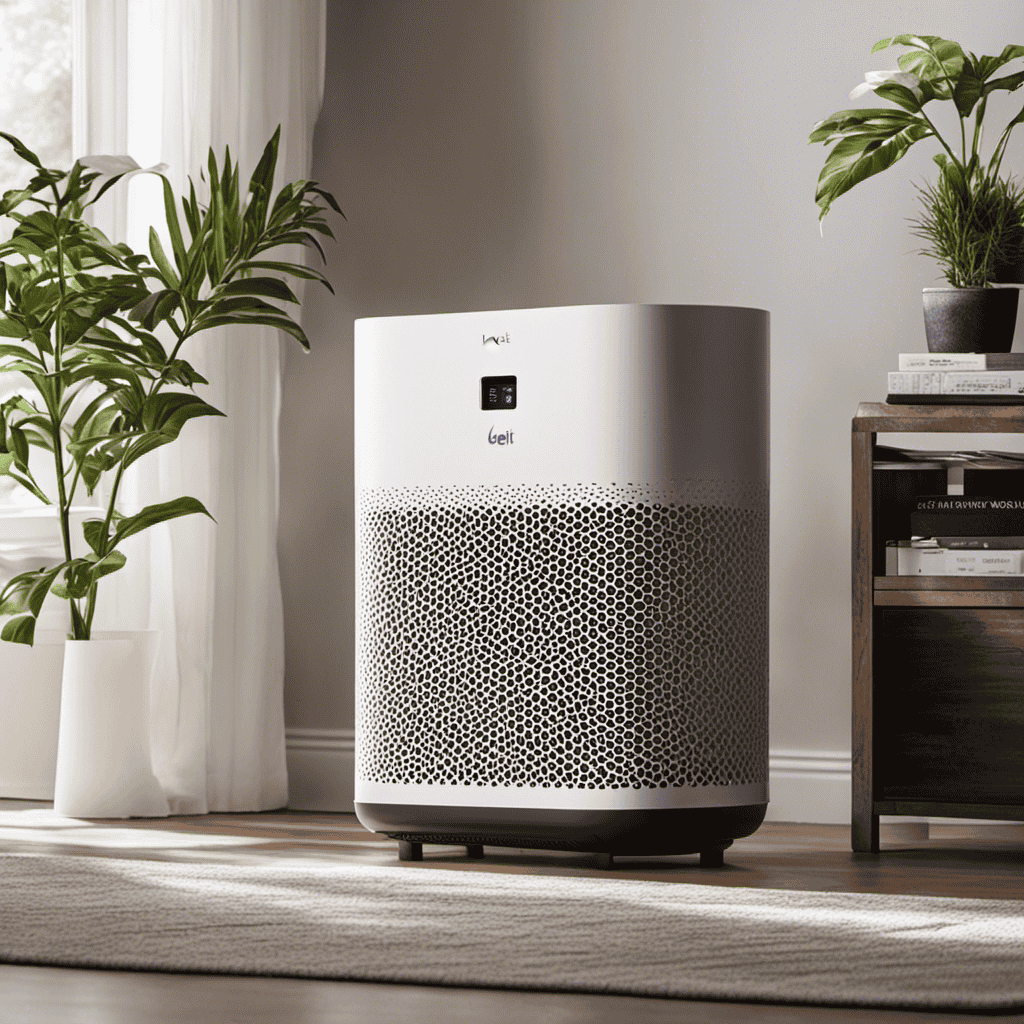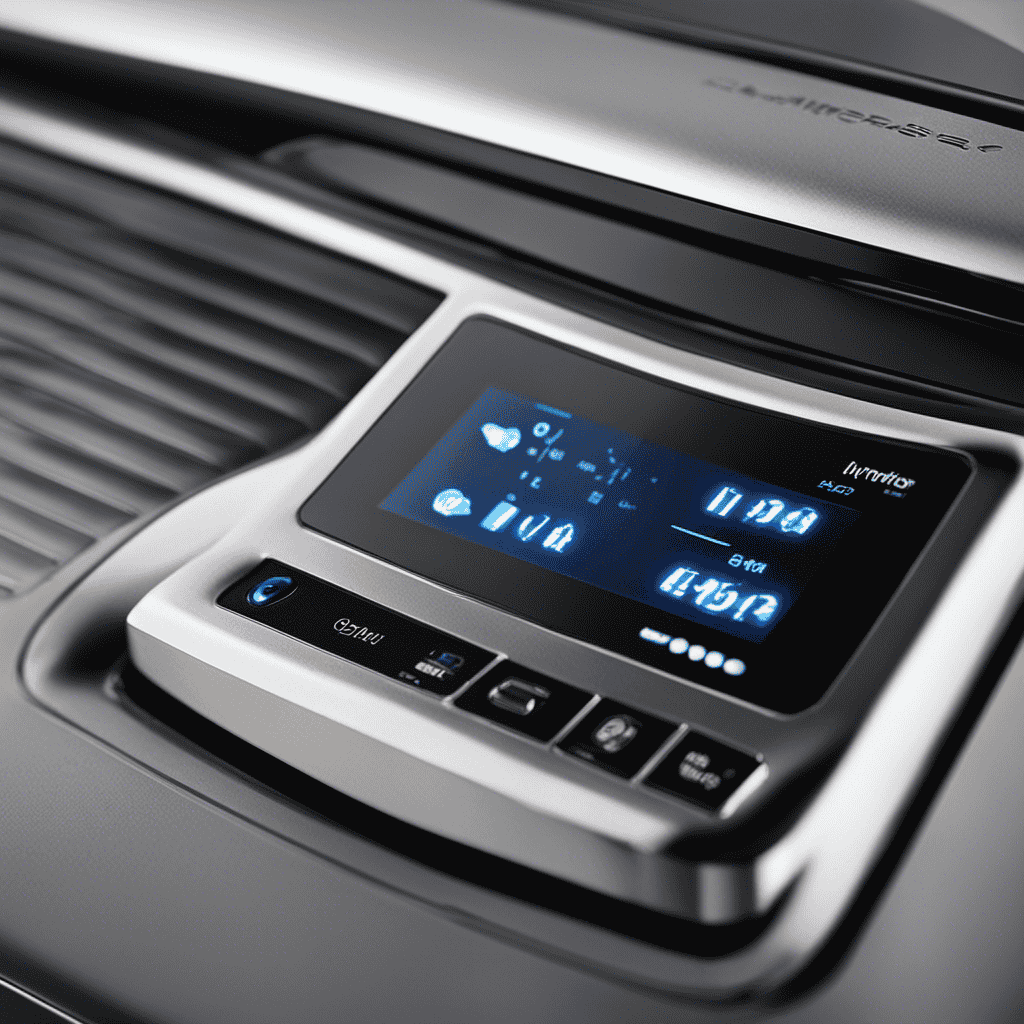What Is an Air Purifier and How Does It Work
As someone who has struggled with allergies and asthma, I was surprised to learn that indoor air can be up to 5 times more polluted than outdoor air! That’s why I became curious about air purifiers and how they work.
In this article, I will explain the basics of air purifiers, discuss common contaminants in indoor air, and explore the different types of air purification technologies available.
So, if you’re interested in improving your indoor air quality, keep reading to learn more.
Key Takeaways
- Air purifiers remove contaminants from the air, improving indoor air quality.
- Different types of filters used in air purifiers include HEPA filters, activated carbon filters, and electrostatic filters.
- The filtration process is crucial for maintaining clean air indoors and helps prevent allergies, asthma attacks, and respiratory illnesses.
- Air purifiers effectively capture and eliminate harmful particles from the air, improving respiratory health.
The Basics of Air Purifiers
Air purifiers are devices that remove contaminants from the air, making it cleaner and healthier to breathe. Understanding filtration is key to understanding how air purifiers work. Filtration is the process of trapping particles and pollutants in a filter, preventing them from being released back into the air. There are different types of filters used in air purifiers, including HEPA filters, activated carbon filters, and electrostatic filters.
HEPA filters are highly efficient at capturing particles as small as 0.3 microns, such as dust, pollen, pet dander, and mold spores. Activated carbon filters are excellent at removing odors, gases, and volatile organic compounds (VOCs) from the air. Electrostatic filters use an electric charge to attract and trap particles.
The benefits of clean air cannot be overstated. Breathing clean air can improve respiratory health, reduce allergies and asthma symptoms, and enhance overall well-being. Air purifiers can also help remove harmful pollutants such as smoke, volatile organic compounds, and bacteria, creating a safer indoor environment. Additionally, clean air can improve sleep quality and boost productivity.
Understanding Air Quality
When it comes to understanding air quality, there are several key points to consider.
First, we need to be aware of the indoor air pollutants that can be present in our homes and workplaces. These pollutants can come from sources such as tobacco smoke, cleaning chemicals, and mold.
Second, it’s important to understand the health effects of pollution, which can range from respiratory issues to more serious conditions like asthma and even cancer.
Finally, we should explore ways to improve air quality, such as using air purifiers, proper ventilation, and reducing exposure to pollutants.
Indoor Air Pollutants
Indoor air pollutants can be reduced with the use of an air purifier. These devices are designed to filter out harmful particles and contaminants from the air, improving the overall air quality in your home or office.
Some common sources of indoor air pollutants include:
- Tobacco smoke: Secondhand smoke can contain over 4,000 chemicals, many of which are known to be toxic or carcinogenic.
- Volatile Organic Compounds (VOCs): These are emitted from various household products such as paints, cleaning agents, and furniture.
- Biological contaminants: These include mold, bacteria, pet dander, and dust mites, which can cause respiratory allergies and infections.
By using an air purifier, you can effectively remove these pollutants and create a healthier indoor environment. This is particularly important because poor indoor air quality has been linked to various health issues, such as respiratory problems, allergies, and even cardiovascular diseases.
Transitioning to the next section, it is crucial to understand the health effects of pollution and how they can be mitigated.
Health Effects of Pollution
Using an air purifier can greatly improve the overall quality of the air in your home or office. Indoor air pollution has negative impacts on our health, particularly on our respiratory system.
The contaminants present in the air can lead to various respiratory diseases such as asthma, bronchitis, and allergies. Research has shown that exposure to these pollutants can exacerbate existing respiratory conditions and even increase the risk of developing new ones.
Air purifiers work by filtering out these harmful particles from the air, effectively reducing the concentration of pollutants. They use different technologies such as HEPA filters, activated carbon filters, and UV sterilization to capture and eliminate pollutants.
Improving Air Quality
Improving the quality of the air in your home or office can greatly benefit your overall health and well-being. With the increase in indoor air pollution, it’s crucial to take steps to reduce contaminants and breathe cleaner air. One effective way to achieve this is by using an air purifier.
Here are some benefits of using an air purifier:
- Removes airborne particles such as dust, pollen, and pet dander.
- Reduces exposure to harmful chemicals and volatile organic compounds (VOCs).
- Helps alleviate symptoms of allergies and asthma.
To further reduce indoor air pollution, consider the following:
- Keep your home well-ventilated by opening windows and using exhaust fans.
- Regularly clean and vacuum to minimize dust and pet hair.
- Avoid smoking indoors and use natural cleaning products.
By taking these measures, you can create a healthier environment and improve the air quality in your home or office.
Now, let’s explore the common contaminants found in indoor air.
Common Contaminants in Indoor Air
One of the most common contaminants in the air we breathe is pollen, which can cause allergies and respiratory issues. However, pollen is just one of many sources of contaminants that contribute to indoor air pollution. Other sources include pet dander, dust mites, mold spores, and volatile organic compounds (VOCs) emitted from cleaning products, paints, and furniture. These contaminants can have harmful effects on our health, particularly for those who suffer from asthma or allergies.
It is important to address indoor air pollution to create a healthier living environment.
To transition into the subsequent section about how air purifiers work, it is essential to understand the importance of removing these contaminants from the air. Air purifiers are devices designed to filter out these contaminants, improving the air quality in indoor spaces. By removing pollutants such as pollen, pet dander, and mold spores, air purifiers can help alleviate symptoms of allergies and asthma. But how exactly do they work? Let’s explore the inner workings of air purifiers and the different types of filters they use to clean the air we breathe.
How Air Purifiers Work
When it comes to improving indoor air quality, understanding the air filtration process and how it eliminates airborne pollutants is crucial.
Air purifiers work by drawing in air from the surrounding environment and passing it through a series of filters designed to capture and trap harmful particles such as dust, pollen, pet dander, and mold spores.
Air Filtration Process
The air purifier uses a filter to remove particles from the air, such as dust, pollen, and pet dander. This process is crucial for maintaining clean air in our indoor environments.
The benefits of air filtration are numerous, as it helps to improve the overall air quality, reduces the risk of respiratory issues, and provides a healthier living space.
Clean air is of utmost importance for our well-being, as it can help prevent allergies, asthma attacks, and other respiratory illnesses. Breathing in clean air also promotes better sleep, increases productivity, and enhances overall quality of life.
Eliminating Airborne Pollutants
In the previous subtopic, we discussed how air purifiers work by filtering out harmful particles from the air. Now, let’s delve into the benefits of using an air purifier and how to properly maintain it.
Air purifiers offer numerous benefits for both our health and well-being. They effectively remove pollutants such as dust, pollen, pet dander, mold spores, and even volatile organic compounds (VOCs) from the air we breathe. This can greatly improve indoor air quality, reducing the risk of respiratory issues and allergies.
To ensure optimal performance, regular maintenance of your air purifier is essential. This includes cleaning or replacing the filters regularly, as clogged filters can impede airflow and decrease efficiency. Additionally, cleaning the unit itself and keeping it in a well-ventilated area will help maintain its effectiveness.
By understanding the benefits of air purifiers and following proper maintenance practices, we can enjoy clean and healthy indoor air.
Now, let’s take a look at the table below to further understand the benefits of using an air purifier and how to maintain it:
| Air Purifier Benefits | Air Purifier Maintenance |
|---|---|
| Removes harmful pollutants | Regularly clean or replace filters |
| Improves indoor air quality | Clean the unit regularly and keep it in a well-ventilated area |
| Reduces respiratory issues | Follow manufacturer’s instructions for maintenance |
| Minimizes allergies | Monitor filter replacement schedule and replace as needed |
Improving Indoor Air Quality
To improve your indoor air quality, it is essential to regularly clean or replace the filters in your air purifier. This simple maintenance task ensures that your air purifier can effectively capture and remove airborne pollutants from your home.
Here are some benefits of maintaining your air purifier:
-
Enhanced air quality: Regularly cleaning or replacing filters in your air purifier helps remove allergens, dust, and other particles from the air. This leads to cleaner and healthier indoor air.
-
Extended lifespan: Proper maintenance of your air purifier can help prolong its lifespan. By taking care of it, you can ensure that it continues to provide clean air for a longer time.
-
Cost savings: By maintaining your air purifier, you can avoid costly repairs or the need to replace the entire unit. This can save you money in the long run.
By understanding the benefits of air purifier maintenance, you can take the necessary steps to keep your indoor air clean and healthy.
Now, let’s explore the different types of air purification technologies.
Types of Air Purification Technologies
Did you know there are different types of air purification technologies that can help improve the air quality in your home? When it comes to choosing an air purifier, it’s important to consider factors such as air purifier maintenance and the specific needs of your household.
Air purifier maintenance is crucial for ensuring optimal performance and longevity of your device. Regularly cleaning and replacing filters is essential to keep the air purifier working effectively. Some models also require additional maintenance, such as cleaning the pre-filter or emptying the water reservoir in a humidifier air purifier. It’s important to read the manufacturer’s instructions and follow the recommended maintenance schedule.
When choosing an air purifier, consider factors such as the size of the room, the type of pollutants you want to target, and the specific features you need. For example, if you have allergies, you may want an air purifier with a HEPA filter to capture allergens like pollen and pet dander. If you live in an area with high levels of air pollution, you may want an air purifier with an activated carbon filter to remove volatile organic compounds (VOCs) and other harmful gases.
HEPA Filters: The Gold Standard
If you’re looking to improve the air quality in your home, HEPA filters are considered the gold standard for capturing allergens and pollutants. These filters are highly effective at removing particles as small as 0.3 microns, including dust, pet dander, pollen, and mold spores.
Here are some benefits and drawbacks of using HEPA filters:
-
Benefits:
-
Captures a wide range of particles: HEPA filters can trap 99.97% of airborne particles, making them ideal for people with allergies or asthma.
-
Improves indoor air quality: By removing pollutants from the air, HEPA filters can help reduce the risk of respiratory problems and improve overall health.
-
Long lifespan: With proper maintenance, HEPA filters can last up to three years, making them a cost-effective option in the long run.
-
Drawbacks:
-
Limited to particles: HEPA filters are not effective at removing gases, odors, or chemicals from the air. For comprehensive air purification, additional methods may be necessary.
-
Regular filter replacement: To maintain optimal performance, HEPA filters need to be replaced regularly, which can be an ongoing expense.
-
Noise levels: Some HEPA filters can produce noise when running, which may be bothersome to noise-sensitive individuals.
While HEPA filters are highly effective, there are alternative air purification methods available. These include activated carbon filters, which can remove odors and chemicals, and UV germicidal lamps, which kill bacteria and viruses. It’s important to determine your specific needs and choose the most suitable air purification method for your home.
Activated Carbon Filters: Odor Eliminators
Now that we have discussed the effectiveness of HEPA filters in capturing airborne particles, let’s move on to another important component of air purifiers: activated carbon filters.
These filters are specifically designed to eliminate odors and chemicals from the air, making them ideal for improving indoor air quality.
Activated carbon filters work through a process called chemical absorption. The carbon in these filters is treated with oxygen, creating millions of tiny pores and a large surface area. When air passes through the filter, these pores trap and absorb various organic compounds and gases, such as volatile organic compounds (VOCs), formaldehyde, and unpleasant odors.
One common application of activated carbon filters is in air fresheners. These filters can effectively remove the smell of smoke, pet odors, cooking fumes, and other unpleasant odors, leaving the air smelling fresh and clean. Additionally, they can also help reduce the levels of harmful chemicals in the air, improving the overall air quality in your home or office.
It is important to note that activated carbon filters have a limited lifespan and need to be replaced regularly to maintain their effectiveness. The frequency of replacement depends on factors such as the level of air pollution and the size of the filter.
Regular maintenance and replacement of activated carbon filters will ensure that your air purifier continues to effectively eliminate odors and chemicals from the air you breathe.
UV-C Light: Killing Germs and Viruses
UV-C light is a type of ultraviolet light that kills germs and viruses by destroying their DNA or RNA. This germicidal property makes it an effective tool in the fight against airborne pathogens.
Here are three key points about UV-C light and its role in air purification:
-
Effective against a wide range of pathogens: UV-C light technology has been proven to be effective against a variety of harmful microorganisms, including bacteria, viruses, and mold spores. It can neutralize these pathogens and prevent them from causing infections or spreading diseases.
-
Disrupts the genetic material: UV-C light works by emitting short-wavelength ultraviolet rays that penetrate the cells of germs and viruses. These rays disrupt the genetic material, either DNA or RNA, preventing the microorganisms from replicating and rendering them harmless.
-
Safe and chemical-free: Unlike some other disinfection methods, UV-C light does not require the use of chemicals or produce harmful byproducts. It is a natural and environmentally friendly solution to purify the air and eliminate harmful pathogens.
In conclusion, UV-C light technology offers a powerful and safe method for killing germs and viruses in the air. Its germicidal properties make it an essential component of air purifiers, ensuring that the air we breathe is clean and free from harmful microorganisms.
Moving forward, let’s explore another effective air purification technology known as ionizers and electrostatic precipitators: air ionization.
Ionizers and Electrostatic Precipitators: Air Ionization
To effectively purify the air, you can consider using ionizers and electrostatic precipitators, which release charged particles to remove pollutants and improve air quality. Air ionization, the process of adding charged particles to the air, has been shown to have several health benefits.
Firstly, ionizers can help to reduce airborne allergens such as pollen, dust mites, and pet dander, which can be particularly beneficial for individuals with allergies or asthma. Additionally, ionizers have been found to effectively remove certain bacteria and viruses from the air, helping to reduce the spread of infections.
However, it is important to note that there are also some drawbacks to using ionizers. One potential concern is the production of ozone, a gas that can be harmful to human health when present in high concentrations. While some ionizers generate low levels of ozone, others may produce higher levels, which can irritate the respiratory system and worsen existing respiratory conditions. It is therefore important to carefully research and select ionizers that have been tested and certified to produce minimal levels of ozone.
In conclusion, while air ionization can offer several health benefits by removing pollutants from the air, it is essential to consider the potential drawbacks, particularly related to ozone generation.
Transitioning to the next section, another type of air purifier to consider is the ozone generator, which has its own set of pros and cons.
Ozone Generators: Pros and Cons
Ozone generators are devices that produce ozone, a highly reactive gas that can be used for air purification.
However, it is important to be aware of the potential health risks associated with ozone exposure. Studies have shown that high levels of ozone can cause respiratory issues, such as coughing, chest pain, and shortness of breath.
Additionally, while ozone can be effective at eliminating certain odors and pollutants, its effectiveness may vary depending on factors such as room size, ventilation, and the specific pollutants present.
Health Risks of Ozone
Using an air purifier can help reduce health risks associated with high levels of ozone in the air. Ozone is a harmful gas that can have detrimental effects on our health, especially when exposed to it for prolonged periods.
Here are some of the risks of ozone exposure and the effects of ozone pollution:
-
Respiratory problems: Ozone can irritate the respiratory system, causing coughing, wheezing, and shortness of breath.
-
Lung damage: Prolonged exposure to high levels of ozone can lead to lung inflammation and damage, increasing the risk of respiratory diseases such as asthma and chronic obstructive pulmonary disease (COPD).
-
Increased susceptibility to infections: Ozone exposure weakens the immune system, making individuals more prone to respiratory infections.
Effectiveness of Ozone
It’s important to understand the effectiveness of ozone in reducing health risks. Ozone, when used correctly and at safe levels, can be an effective tool in improving indoor air quality. Ozone works by reacting with pollutants in the air, neutralizing them and reducing their harmful effects.
However, it’s crucial to consider ozone safety and ensure that ozone levels are within the recommended limits. High concentrations of ozone can be harmful to human health, causing respiratory issues and other adverse effects. Therefore, it is essential to choose an air purifier that uses ozone responsibly and has built-in safety features to control ozone levels.
Choosing the Right Air Purifier for Your Needs
When selecting an air purifier, it’s important to consider your specific needs and requirements. Here are some key factors to keep in mind:
-
Considerations for different room sizes: Air purifiers come in various sizes and have different coverage areas. It’s crucial to choose a purifier that is suitable for the size of the room you intend to use it in. A larger room may require a purifier with higher CADR (Clean Air Delivery Rate) to effectively clean the air.
-
Energy efficiency of air purifiers: Look for purifiers that are ENERGY STAR certified, as they are designed to consume less energy without compromising on performance. This not only helps you save on electricity bills but also reduces your carbon footprint.
-
Filtration technology: Different air purifiers use different filtration technologies such as HEPA filters, activated carbon filters, or electrostatic precipitators. Consider your specific needs, such as removing allergens, odors, or volatile organic compounds (VOCs), and choose a purifier that employs the appropriate filtration technology.
By carefully considering these factors, you can select an air purifier that meets your needs while being energy-efficient.
Once you have chosen the right purifier, it is important to maintain and clean it regularly to ensure optimal performance and longevity.
Maintaining and Cleaning Your Air Purifier
To keep your air purifier running efficiently, you should regularly clean and maintain it. Proper maintenance of your air purifier ensures that it continues to effectively remove pollutants from the air and improves the overall air quality in your home or office. Cleaning and maintaining an air purifier involves a few simple steps that can significantly extend its lifespan and maximize its performance.
Here is a table outlining the key steps for maintaining and cleaning your air purifier:
| Step | Frequency | Description |
|---|---|---|
| 1 | Monthly | Replace or clean the filters. |
| 2 | Quarterly | Clean the exterior of the unit. |
| 3 | Annually | Deep clean the internal components. |
| 4 | As needed | Replace any malfunctioning parts. |
| 5 | Regularly | Monitor the air quality and adjust settings accordingly. |
Regularly cleaning or replacing the filters is crucial for the proper functioning of the air purifier. Over time, the filters become clogged with dust, allergens, and other particles, reducing their effectiveness. Cleaning the exterior of the unit prevents dust buildup and ensures optimal airflow. Additionally, deep cleaning the internal components, such as the fan and vents, helps remove any accumulated dirt or debris.
Tips for Improving Indoor Air Quality
If you want to improve the quality of the air in your home or office, start by regularly cleaning and maintaining your air purifier. An air purifier works by removing impurities from the air, such as dust, pollen, pet dander, and mold spores. By preventing these allergens from circulating in the air, it can help prevent allergies and reduce asthma symptoms.
Here are some tips for improving indoor air quality:
-
Keep your air purifier clean: Regularly clean the filters and replace them as necessary. This will ensure that the purifier is functioning optimally and effectively removing pollutants from the air.
-
Control humidity levels: High humidity can promote mold growth, so use a dehumidifier to keep humidity levels between 30-50%. This will help prevent the spread of mold spores in the air.
-
Keep indoor spaces clean: Regularly vacuum and dust your home or office to remove dust mites, pet dander, and other allergens. This will help reduce the amount of pollutants in the air that can trigger allergies and asthma symptoms.
Frequently Asked Questions
Are Air Purifiers Safe for Pets and Children?
Yes, air purifiers are generally safe for pets and children. However, it is important to choose an air purifier that is specifically designed to remove pet dander, allergens, and other particles that can be harmful to their health.
Look for air purifiers with HEPA filters, as they are highly effective in capturing small particles. Additionally, regular maintenance of the air purifier, such as changing filters, is crucial to ensure its continued effectiveness and minimize any potential health risks.
Can Air Purifiers Remove Strong Odors Like Cigarette Smoke?
Yes, air purifiers can effectively remove strong odors like cigarette smoke. They work by using filters to capture and trap particles and contaminants in the air, including smoke particles and the odors they carry.
By removing these particles, air purifiers can help improve indoor air quality and reduce odors. This is especially beneficial for individuals with allergies or sensitivities to smoke.
Using an air purifier can provide cleaner, fresher air and alleviate symptoms caused by smoke exposure.
How Often Should I Replace the Filters in My Air Purifier?
When it comes to the filter replacement frequency of an air purifier, it depends on several factors. These factors include the type of purifier, the quality of the filters, and the level of air pollution in your surroundings. Generally, it is recommended to replace the filters every 6 to 12 months for optimal performance. However, it is important to check the manufacturer’s guidelines for specific maintenance tips and instructions regarding filter replacement.
Do Air Purifiers Consume a Lot of Energy?
Air purifiers are amazing devices that clean the air we breathe.
When it comes to energy consumption, some might worry that they consume a lot of power. However, the truth is that air purifiers are actually quite energy-efficient. They use minimal electricity to operate, making them an environmentally friendly choice.
Can Air Purifiers Prevent the Spread of Airborne Diseases Like Covid-19?
Air purifiers play a crucial role in improving indoor air quality and can potentially help prevent the spread of airborne diseases like COVID-19. They remove harmful particles and pollutants from the air, including viruses and bacteria, creating a safer and healthier environment.
By trapping and filtering these airborne particles, air purifiers reduce the risk of transmission. This is particularly beneficial for individuals with respiratory conditions or weakened immune systems.
Investing in an air purifier can have significant long-term health benefits.
Conclusion
In conclusion, air purifiers are essential devices for improving indoor air quality. They work by removing common contaminants such as dust, pollen, and pet dander from the air.
With various types of air purification technologies available, such as HEPA filters and activated carbon filters, you can choose the right one for your specific needs.
Maintaining and cleaning your air purifier regularly is important to ensure its effectiveness.
Just like a breath of fresh air on a sunny day, air purifiers can make your indoor environment clean and refreshing.










